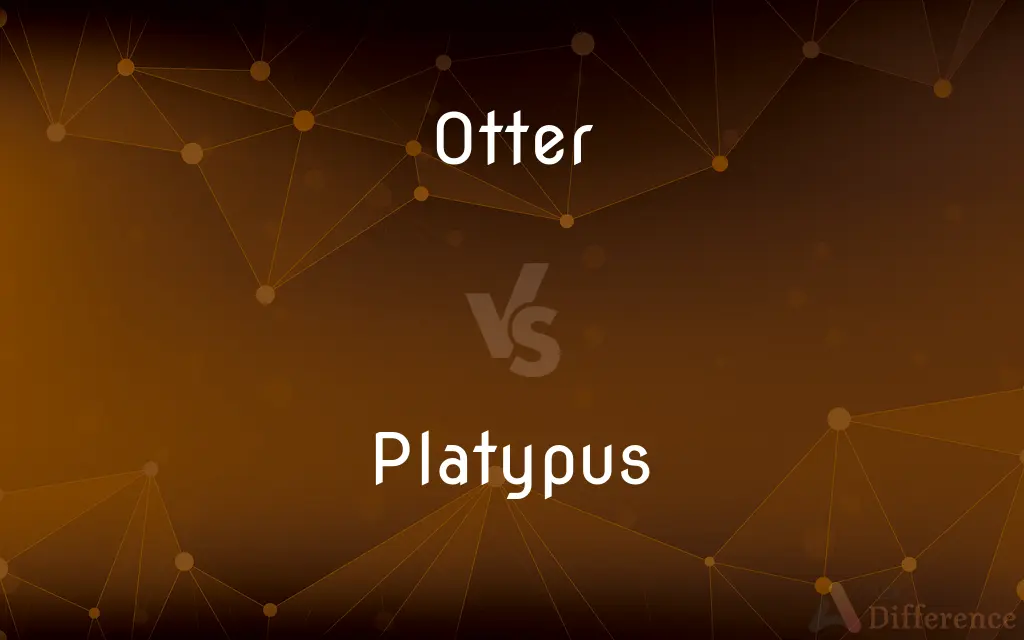Otter vs. Platypus — What's the Difference?
By Fiza Rafique & Maham Liaqat — Updated on April 27, 2024
Otters are carnivorous mammals known for their streamlined bodies and aquatic skills, whereas platypuses are unique egg-laying mammals with duck-like bills and venomous spurs.

Difference Between Otter and Platypus
Table of Contents
ADVERTISEMENT
Key Differences
Otters belong to the family Mustelidae, which includes weasels and badgers, and are adapted to a semi-aquatic lifestyle with their webbed feet and water-repellent fur. Whereas, the platypus, part of the Monotremata order, is one of the few mammals that lay eggs and is native to eastern Australia.
Otters have elongated, flexible bodies with a significant tail that aids in swimming; they primarily eat fish and shellfish. On the other hand, platypuses possess a distinctive duck-bill that serves as a sensor to detect prey underwater, feeding mainly on aquatic invertebrates.
In terms of reproduction, otters give birth to live young and nurture them in dens along the water's banks. Conversely, the platypus lays eggs in burrows near water bodies, which is highly unusual for mammals.
Otters are social creatures, often seen in groups, and are known for their playful behavior, such as using stones to crack open shellfish. Platypuses are more solitary, rarely seen together except during the breeding season.
While otters are found in various freshwater and coastal marine environments across multiple continents, platypuses are endemic to Tasmania and the eastern and southeastern coast of Australia, highlighting their limited distribution.
ADVERTISEMENT
Comparison Chart
Classification
Mammalia, Mustelidae
Mammalia, Monotremata
Habitat
Freshwater and coastal marine waters
Freshwater rivers and lakes
Reproduction
Viviparous (gives birth to live young)
Oviparous (lays eggs)
Social Behavior
Social, often in groups
Solitary except during breeding season
Distinctive Features
Elongated body, uses tools
Duck-like bill, venomous spur
Compare with Definitions
Otter
Social creatures that live in groups.
A romp of otters was seen frolicking in the water.
Platypus
An egg-laying mammal with a duck-like bill.
The platypus foraged along the riverbed with its sensitive bill.
Otter
A member of the weasel family known for aquatic skills.
The otter slid gracefully into the river.
Platypus
Possesses a venomous spur on its hind limb.
The male platypus's spur can deliver a painful injection of venom.
Otter
Uses complex hunting techniques.
The otter used a stone to break open the clam.
Platypus
Uses electrolocation to find prey underwater.
The platypus detects prey through electric fields generated by muscular contractions.
Otter
Carnivorous mammals with elongated bodies.
Otters are often observed cracking shells with rocks.
Platypus
Native to eastern Australia, inhabiting freshwater environments.
Platypuses are elusive creatures rarely seen by humans.
Otter
Playful animals found in both fresh and marine waters.
Otters play by sliding down muddy or snowy slopes.
Platypus
Solitary except during breeding season.
The solitary platypus is a shy and reclusive animal.
Otter
Otters are carnivorous mammals in the subfamily Lutrinae. The 13 extant otter species are all semiaquatic, aquatic or marine, with diets based on fish and invertebrates.
Platypus
The platypus (Ornithorhynchus anatinus), sometimes referred to as the duck-billed platypus, is a semiaquatic, egg-laying mammal endemic to eastern Australia, including Tasmania. The platypus is the sole living representative of its family (Ornithorhynchidae) and genus (Ornithorhynchus), though a number of related species appear in the fossil record.
Otter
A semiaquatic fish-eating mammal of the weasel family, with an elongated body, dense fur, and webbed feet.
Platypus
A semiaquatic egg-laying mammal which frequents lakes and streams in eastern Australia. It has a sensitive pliable bill shaped like that of a duck, webbed feet with venomous spurs, and dense fur.
Otter
A piece of board used to carry fishing bait in water.
Platypus
A semiaquatic egg-laying mammal (Ornithorhynchus anatinus) of eastern Australia and Tasmania, having a broad flat tail, webbed feet, a snout resembling a duck's bill, and in the male, venomous spurs on the hind legs. Also called duckbill, duck-billed platypus.
Otter
Any of various aquatic or semiaquatic carnivorous mammals of the mustelid subfamily Lutrinae, having webbed feet and dense, dark brown fur.
Platypus
A semi-aquatic, egg-laying monotreme mammal with a bill resembling that of a duck, that has a mole-like body, a tail resembling that of a beaver, a waterproof pelt, and flat webbed feet — males have poisonous spurs on the inside of the back legs; Ornithorhynchus anatinus
Otter
The fur of one of these animals.
Platypus
The duck mole. See under Duck.
Otter
An aquatic or marine carnivorous mammal in the subfamily Lutrinae of the family Mustelidae, which also includes weasels, polecats, badgers, and others.
Platypus
Small densely furred aquatic monotreme of Australia and Tasmania having a broad bill and tail and webbed feet; only species in the family Ornithorhynchidae
Otter
(gay slang) A hairy man with a slender physique, in contrast with a bear, who is more thickset.
Otter
(obsolete) annatto dye
Otter
The larva of the ghost moth. It is very injurious to hop vines.
Otter
A corruption of Annotto.
Otter
The fur of an otter
Otter
Freshwater carnivorous mammal having webbed and clawed feet and dark brown fur
Common Curiosities
How do otters hunt?
Otters use their agility in water and tools like rocks to hunt fish and shellfish.
What family do otters belong to?
Otters are part of the Mustelidae family.
Are platypuses venomous?
Yes, male platypuses have a venomous spur on their hind limbs.
What makes the platypus unique among mammals?
The platypus is unique for being an egg-laying mammal with electrolocation capabilities.
Do otters live in groups?
Yes, otters are often found in groups and are known for their social behavior.
What is the habitat preference of a platypus?
Platypuses prefer freshwater environments such as rivers and lakes.
How do otters care for their young?
Otters give birth to live young and raise them in dens near water bodies.
What diet do otters follow?
Otters are primarily carnivorous, feeding on fish and shellfish.
Where can you find platypuses?
Platypuses are native to eastern Australia, especially in Tasmania and along the eastern coast.
Can otters use tools?
Yes, otters are known to use rocks as tools to open shellfish.
Are platypuses good swimmers?
Yes, platypuses are excellent swimmers and spend much of their time underwater.
Do both otters and platypuses live in water?
Yes, both are aquatic animals, but otters are more versatile, inhabiting both freshwater and marine environments.
How does the platypus find its food?
The platypus uses its bill to detect the electric fields emitted by its prey underwater.
What type of social structure do otters have?
Otters can live in large social groups, engaging in communal activities.
How rare are platypuses?
Platypuses are considered rare due to their specific habitat needs and secretive nature.
Share Your Discovery

Previous Comparison
Dome vs. Vault
Next Comparison
Precept vs. StatuteAuthor Spotlight
Written by
Fiza RafiqueFiza Rafique is a skilled content writer at AskDifference.com, where she meticulously refines and enhances written pieces. Drawing from her vast editorial expertise, Fiza ensures clarity, accuracy, and precision in every article. Passionate about language, she continually seeks to elevate the quality of content for readers worldwide.
Co-written by
Maham Liaqat















































